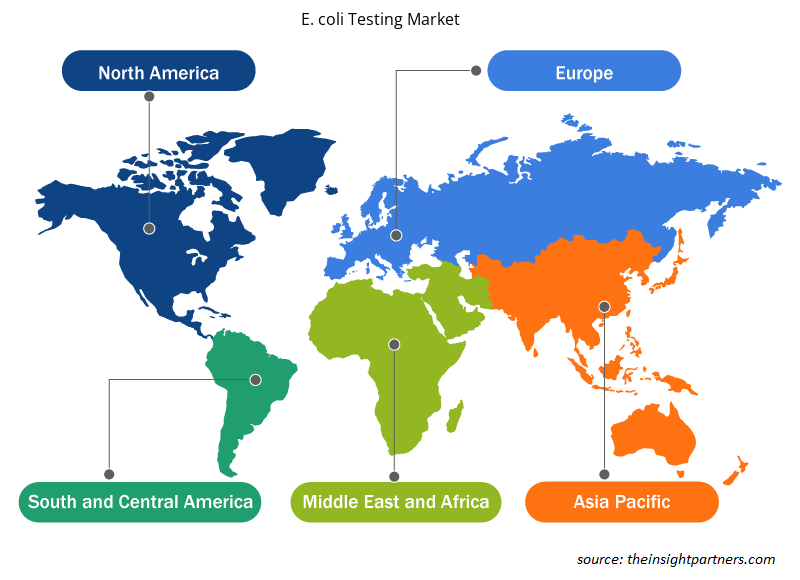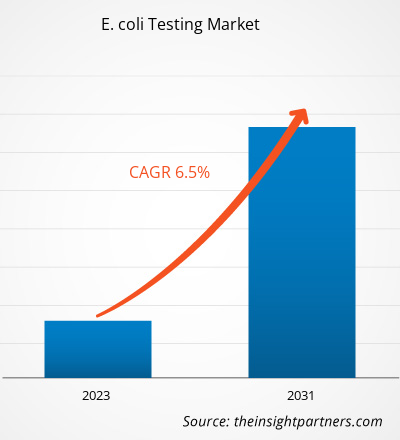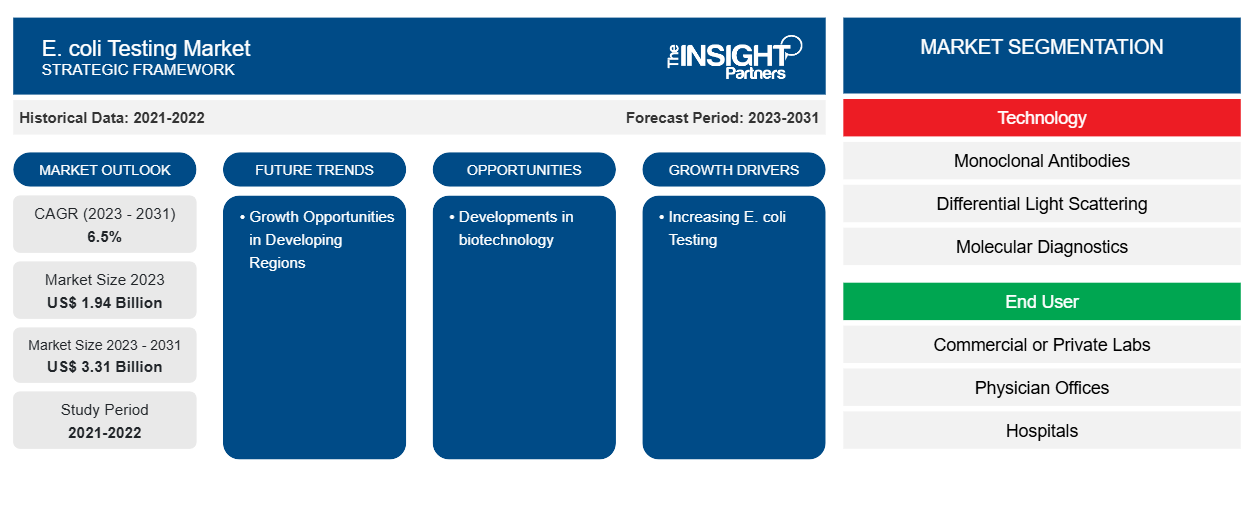Le marché des tests E. coli était évalué à 1,94 milliard USD en 2023 et devrait atteindre 3,31 milliards USD d'ici 2031. Le marché devrait enregistrer un TCAC de 6,5 % en 2023-2031. Les développements en biotechnologie resteront probablement une tendance clé du marché des tests E. coli.coli testing market was valued at US$ 1.94 billion in 2023 and is expected to reach US$ 3.31 billion by 2031. The market is expected to register a CAGR of 6.5% in 2023–2031. Developments in biotechnology will likely remain a key E. coli testing market trend.
Analyse du marché des tests E. coli
Les Escherichia coli (E. coli) sont des bactéries Gram négatives en forme de bâtonnets généralement présentes dans les aliments, l'environnement et les intestins des animaux à sang chaud. La majorité des souches d'E. coli sont généralement inoffensives pour l'homme. Cependant, certaines souches sont reconnues comme étant à l'origine de complications médicales graves, telles que des infections du tractus gastro-intestinal, une cholécystite, une cholangite, une méningite néonatale, une bactériémie, une pneumonie, une infection des voies urinaires (IVU) et se propagent régulièrement via des aliments ou de l'eau pollués. Les facteurs clés qui stimulent le marché, tels que l'augmentation des tests d'E. coli, l'innovation croissante des produits et l'augmentation des activités de recherche, devraient propulser la croissance du marché. Cependant, les défis liés aux tests constituent le principal facteur entravant la croissance du marchécoli (E. coli) are rod-shaped gram-negative coli strains are typically harmless to humans. Still, some strains are recognized as the reason for serious medical complications, such as gastrointestinal tract infections, cholecystitis, cholangitis, neonatal meningitis, bacteremia, pneumonia, urinary tract infection (UTI), and regularly spread via polluted food or water. Key factors driving the market, such as increasing E. coli testing, growing product innovation, and rising research activities, are expected to propel the market's growth. However, testing challenges is the major factor hindering the market growth
Aperçu du marché des tests E. coli
La sensibilisation à l'hygiène, les réglementations gouvernementales strictes et la présence de tous les acteurs régionaux clés sont les principaux facteurs moteurs de ce marché. En outre, les dépenses élevées en R&D pour développer de nouveaux produits de diagnostic et les infrastructures sophistiquées sont des facteurs importants qui propulsent la croissance du marché. En outre, l'augmentation du financement gouvernemental pour les infrastructures de santé et les avancées technologiques dans les procédures de diagnostic d'E. coli, les principaux acteurs du marché aux États-Unis et la sensibilisation à l'hygiène stimulent la croissance du marché.
Personnalisez ce rapport en fonction de vos besoins
Vous bénéficierez d'une personnalisation gratuite de n'importe quel rapport, y compris de certaines parties de ce rapport, d'une analyse au niveau des pays, d'un pack de données Excel, ainsi que de superbes offres et réductions pour les start-ups et les universités.
-
Obtenez les principales tendances clés du marché de ce rapport.Cet échantillon GRATUIT comprendra une analyse de données, allant des tendances du marché aux estimations et prévisions.
Moteurs et opportunités du marché des tests E. coli
Augmentation des tests de détection d'E. coli coli Testing
Escherichia coli est un grand groupe de bactéries d'origine alimentaire présentes dans les aliments, l'environnement et les intestins des animaux et des humains. Bien que la plupart des types d'E. coli soient inoffensifs et contribuent à la santé du tube digestif, quelques souches peuvent provoquer des infections des voies digestives, des maladies respiratoires et une pneumonie, entre autres. La plupart des cas d'intoxication alimentaire et de maladies infectieuses sont dus à E. coli. Il est donc essentiel de détecter la concentration d'E. coli dans divers produits. Outre les secteurs industriels tels que les secteurs pharmaceutique, biotechnologique et environnemental, le secteur des aliments et des boissons présente un risque plus élevé de contamination par E. coli. Les entreprises du secteur agroalimentaire doivent détecter et surveiller la présence de la bactérie avant de démarrer la production, pendant le processus de production et dans les produits finis.coli is a large group of foodborne bacteria found in food, the environment, and the intestines of animals and humans. Although most types of E coli are harmless and help keep the digestive tract healthy, a few strains can cause tract infections, respiratory illness, and pneumonia, among others. Most instances of food poisoning and infectious diseases is caused due to E. coli. Therefore, detecting the concentration E. coli in various products is essential. Apart from industrial sectors such as pharmaceutical, biotechnology, and environmental, the food & coli contamination. Food & beverage companies must detect and monitor the presence of the bacteria before starting production, during the production process, and in the final products.
Opportunités de croissance dans les régions en développement – Une opportunité sur le marché des tests E. colicoli Testing Market
Des régions comme l’Asie-Pacifique, le Moyen-Orient, l’Afrique et l’Amérique latine développent plus rapidement leur secteur de la santé. Ces pays explorent de nouvelles techniques en collaborant avec des organisations de biotechnologie bien établies dans les régions développées. Des pays comme l’Inde, le Brésil, les Émirats arabes unis, l’Arabie saoudite et la Corée du Sud ont augmenté leurs investissements dans le développement du secteur de la biotechnologie. Par exemple, le gouvernement des Émirats arabes unis a lancé un projet appelé DuBiotech, ou Dubai Biotechnology and Research Park en 2005.UAE, Saudi Arabia, and South Korea have increased their investments for the development biotechnology sector. For instance, the UAE government launched a project called DuBiotech, or Dubai Biotechnology and Research Park in 2005.
Le gouvernement a investi 35,4 millions de dollars (130 millions d'AED) dans les infrastructures et 163,4 millions de dollars (600 millions d'AED) dans les laboratoires et les bâtiments du siège. De même, le ministère indien de la biotechnologie devrait faire en sorte que l'industrie indienne de la biotechnologie vaille 100 milliards de dollars d'ici 2025. Ainsi, l'augmentation des investissements dans le secteur de la biotechnologie devrait stimuler les opportunités de croissance pour les services et installations de test d'E. coli dans les régions en développement. En outre, les régions comptent un nombre croissant de start-ups de biotechnologie contribuant au développement du secteur de la biotechnologie. Diverses start-ups ont lancé leurs produits et services innovants dans le domaine de la biotechnologie, ce qui devrait influencer la croissance du marché au cours de la période de prévision.
Analyse de segmentation du rapport sur le marché des tests E. coli
Les segments clés qui ont contribué à l’élaboration de l’analyse du marché des tests d’E. coli sont les prestataires de services et de troubles.
- En fonction de la technologie de test, le marché des tests E. coli est segmenté en anticorps monoclonaux, diffusion différentielle de la lumière, diagnostics moléculaires, immuno-essais, chromatographie, cytométrie de flux, microgouttelettes de gel et imagerie diagnostique. Le segment des anticorps monoclonaux détenait une part de marché plus importante en 2023.
- En termes d'utilisateurs finaux, le marché des tests E. coli est segmenté en laboratoires commerciaux ou privés, cabinets médicaux, hôpitaux, laboratoires de santé publique et instituts de recherche universitaires. Le segment des laboratoires de santé publique détenait la plus grande part du marché en 2023.
Analyse des parts de marché des tests E. coli par géographie
La portée géographique du rapport sur le marché des tests E. coli est principalement divisée en cinq régions : Amérique du Nord, Asie-Pacifique, Europe, Moyen-Orient et Afrique, et Amérique du Sud/Amérique du Sud et centrale.
En Amérique du Nord, les États-Unis constituent le plus grand marché pour les tests de détection d'E. coli. La croissance de ce marché est principalement due à l'augmentation du financement public des infrastructures de santé et aux progrès technologiques dans les procédures de diagnostic d'E. coli. La présence d'acteurs majeurs du marché aux États-Unis et la sensibilisation à l'hygiène accéléreront la croissance de ce marché dans ce pays.
E. coli O157:H7 est l'une des souches qui produit une toxine appelée Shiga. C'est l'une des toxines les plus puissantes et elle peut provoquer une infection intestinale. Selon le ministère de la Santé et des Services sociaux de Caroline du Nord, environ 265 000 infections à E. coli produisant des toxines Shiga (STEC) surviennent chaque année aux États-Unis. Environ 36 % d'entre elles sont probablement causées par E. coli O157:H7. De plus, les infections urinaires entraînent environ 8 millions de consultations médicales et plus de 100 000 hospitalisations aux États-Unis, ce qui représente un coût annuel associé de 1,6 milliard de dollars.
Aperçu régional du marché des tests E. coli
Les tendances régionales et les facteurs influençant le marché des tests E. coli tout au long de la période de prévision ont été expliqués en détail par les analystes d’Insight Partners. Cette section traite également des segments et de la géographie du marché des tests E. coli en Amérique du Nord, en Europe, en Asie-Pacifique, au Moyen-Orient et en Afrique, ainsi qu’en Amérique du Sud et en Amérique centrale.

- Obtenez les données régionales spécifiques au marché des tests E. coli
Portée du rapport sur le marché des tests E. coli
| Attribut de rapport | Détails |
|---|---|
| Taille du marché en 2023 | 1,94 milliard de dollars américains |
| Taille du marché d'ici 2031 | 3,31 milliards de dollars américains |
| Taux de croissance annuel composé mondial (2023-2031) | 6,5% |
| Données historiques | 2021-2022 |
| Période de prévision | 2023-2031 |
| Segments couverts |
Par technologie
|
| Régions et pays couverts |
Amérique du Nord
|
| Leaders du marché et profils d'entreprises clés |
|
Densité des acteurs du marché des tests E. coli : comprendre son impact sur la dynamique commerciale
Le marché des tests E. coli connaît une croissance rapide, tirée par la demande croissante des utilisateurs finaux en raison de facteurs tels que l'évolution des préférences des consommateurs, les avancées technologiques et une plus grande sensibilisation aux avantages du produit. À mesure que la demande augmente, les entreprises élargissent leurs offres, innovent pour répondre aux besoins des consommateurs et capitalisent sur les tendances émergentes, ce qui alimente davantage la croissance du marché.
La densité des acteurs du marché fait référence à la répartition des entreprises ou des sociétés opérant sur un marché ou un secteur particulier. Elle indique le nombre de concurrents (acteurs du marché) présents sur un marché donné par rapport à sa taille ou à sa valeur marchande totale.
Les principales entreprises opérant sur le marché des tests E. coli sont :
- LABORATOIRES BIO-RAD INC.
- Pro Lab Diagnostics Inc.
- Abbott
- LABORATOIRES IDEXX, INC.
- MERIDIAN BIOSCIENCE, INC
- Thermo Fisher Scientific Inc.
Avis de non-responsabilité : les sociétés répertoriées ci-dessus ne sont pas classées dans un ordre particulier.

- Obtenez un aperçu des principaux acteurs du marché des tests E. coli
Actualités et développements récents du marché des tests E. coli
Le marché des tests E. coli est évalué en collectant des données qualitatives et quantitatives après des recherches primaires et secondaires, qui comprennent d'importantes publications d'entreprise, des données d'association et des bases de données. Voici une liste des évolutions du marché des tests E. coli :
- Le kit de test de l'eau E. Coli, basé sur un milieu enzymatique-substrat, a été créé par des chercheurs de l'Indian Institute of Technology (IIT) de Kanpur. Il permet d'identifier si E. Coli est présent ou non dans l'eau potable. (Source : Article de recherche, 2022).
- Afin de mieux comprendre la diversité et les effets de ces mêmes bactéries, des chercheurs de l’Université d’État du Michigan ont mené des expériences avec Escherichia coli. Selon les chercheurs, cette expérience démontre que les avantages de la variété précoce ont été rapidement perdus au fil des générations suivantes, ce qui indique que les mutations aléatoires servent de catalyseur principal à l’évolution d’E. coli. (Source : Université d’État du Michigan, communiqué de presse, 2022).
Rapport sur le marché des tests E. coli : couverture et livrables
Le rapport « Taille et prévisions du marché des tests E. coli (2021-2031) » fournit une analyse détaillée du marché couvrant les domaines ci-dessous :
- Taille du marché et prévisions aux niveaux mondial, régional et national pour tous les segments de marché clés couverts par le périmètre
- Dynamique du marché, comme les facteurs moteurs, les contraintes et les opportunités clés
- Principales tendances futures
- Analyse détaillée des cinq forces de PEST/Porter et SWOT
- Analyse du marché mondial et régional couvrant les principales tendances du marché, les principaux acteurs, les réglementations et les développements récents du marché
- Analyse du paysage industriel et de la concurrence couvrant la concentration du marché, l'analyse de la carte thermique, les principaux acteurs et les développements récents
- Profils d'entreprise détaillés
- Analyse historique (2 ans), année de base, prévision (7 ans) avec TCAC
- Analyse PEST et SWOT
- Taille du marché Valeur / Volume - Mondial, Régional, Pays
- Industrie et paysage concurrentiel
- Ensemble de données Excel
Rapports récents
Rapports connexes
Témoignages
Raison d'acheter
- Prise de décision éclairée
- Compréhension de la dynamique du marché
- Analyse concurrentielle
- Connaissances clients
- Prévisions de marché
- Atténuation des risques
- Planification stratégique
- Justification des investissements
- Identification des marchés émergents
- Amélioration des stratégies marketing
- Amélioration de l'efficacité opérationnelle
- Alignement sur les tendances réglementaires























 Obtenez un échantillon gratuit pour - Marché des tests E. coli
Obtenez un échantillon gratuit pour - Marché des tests E. coli